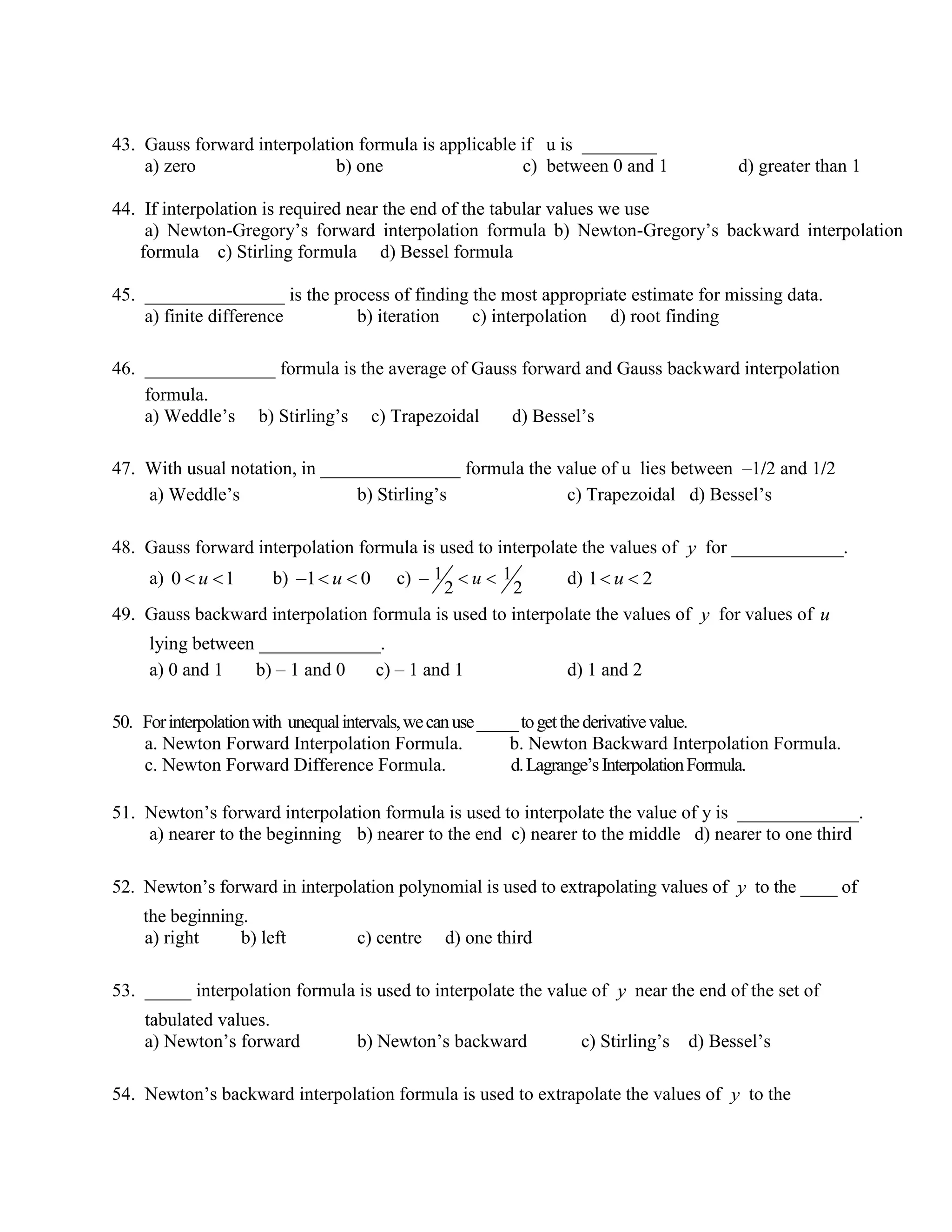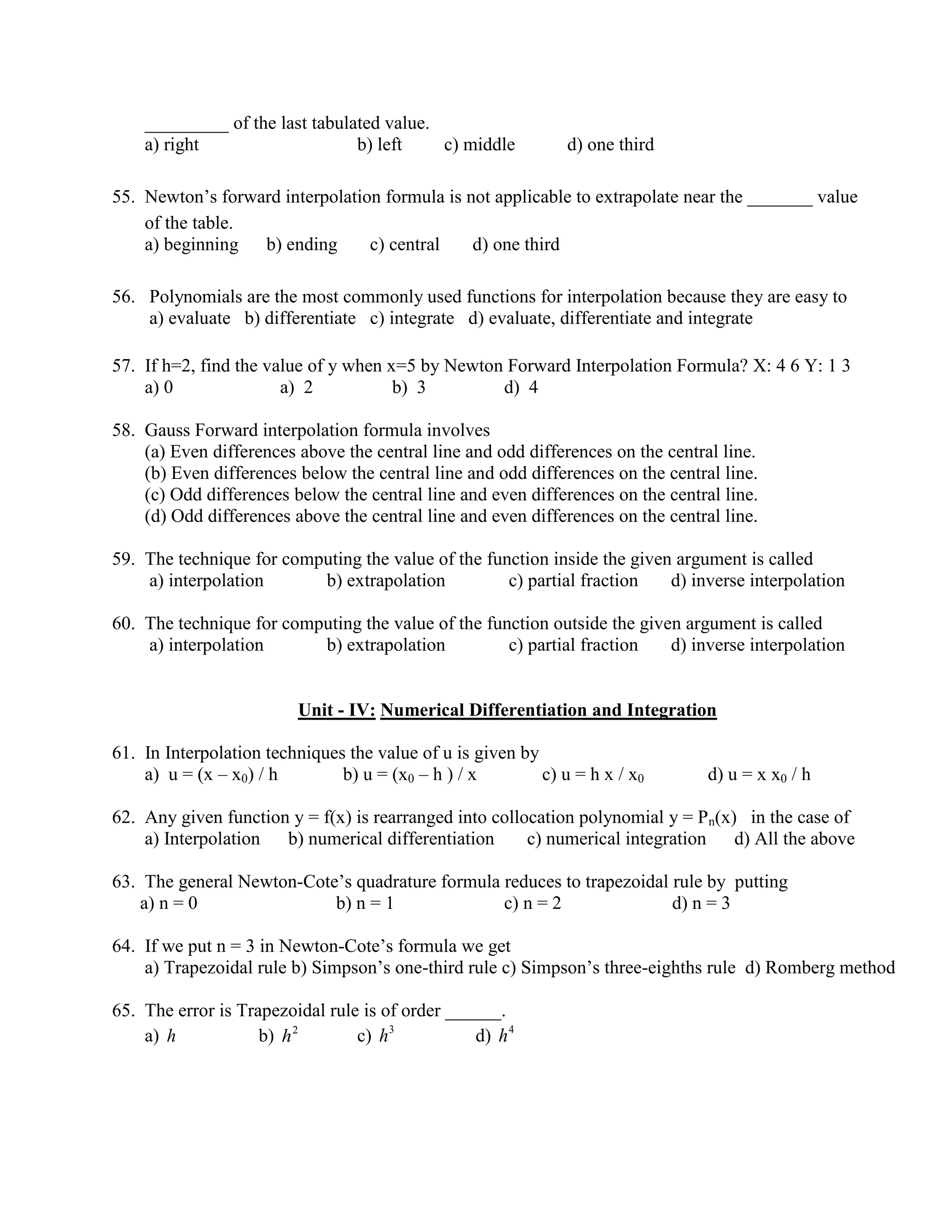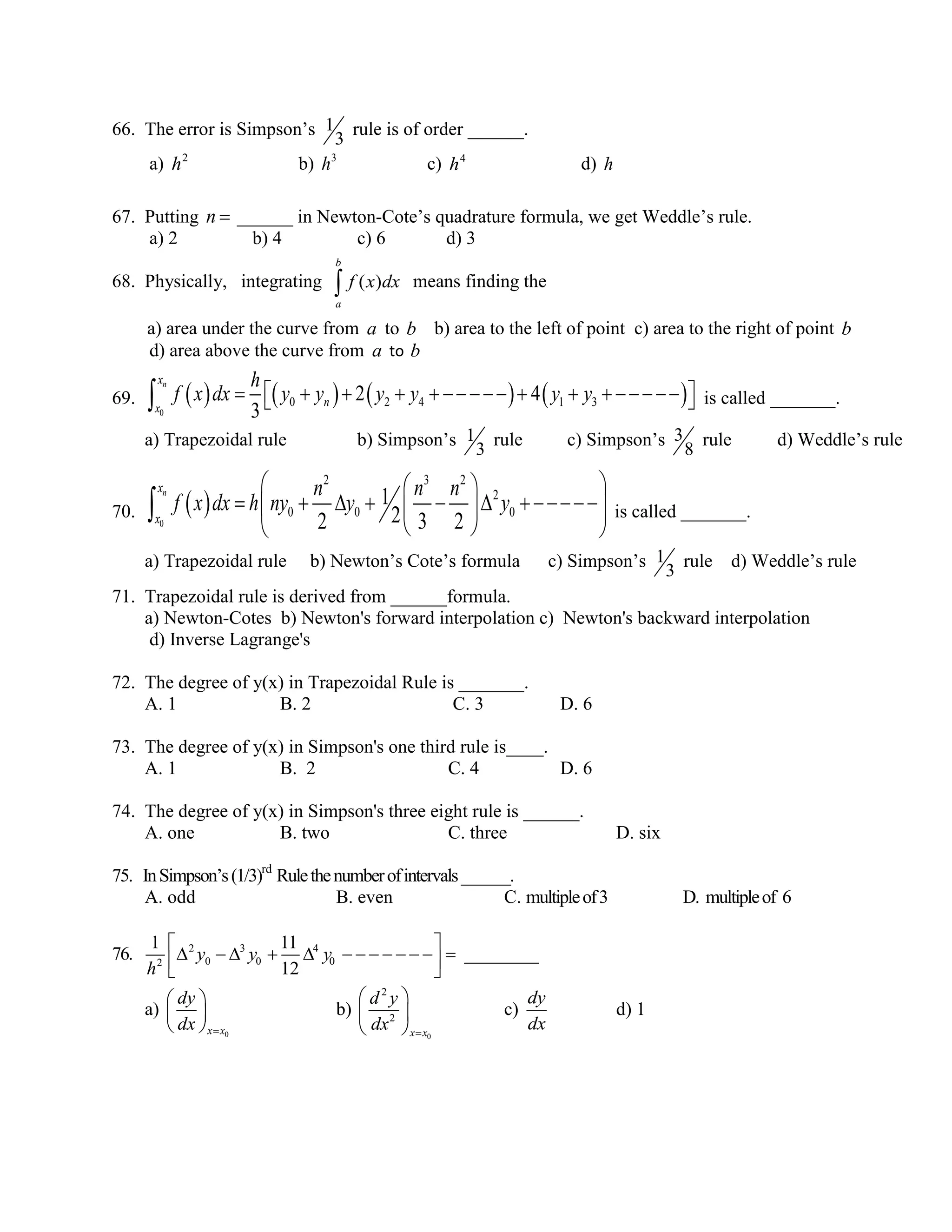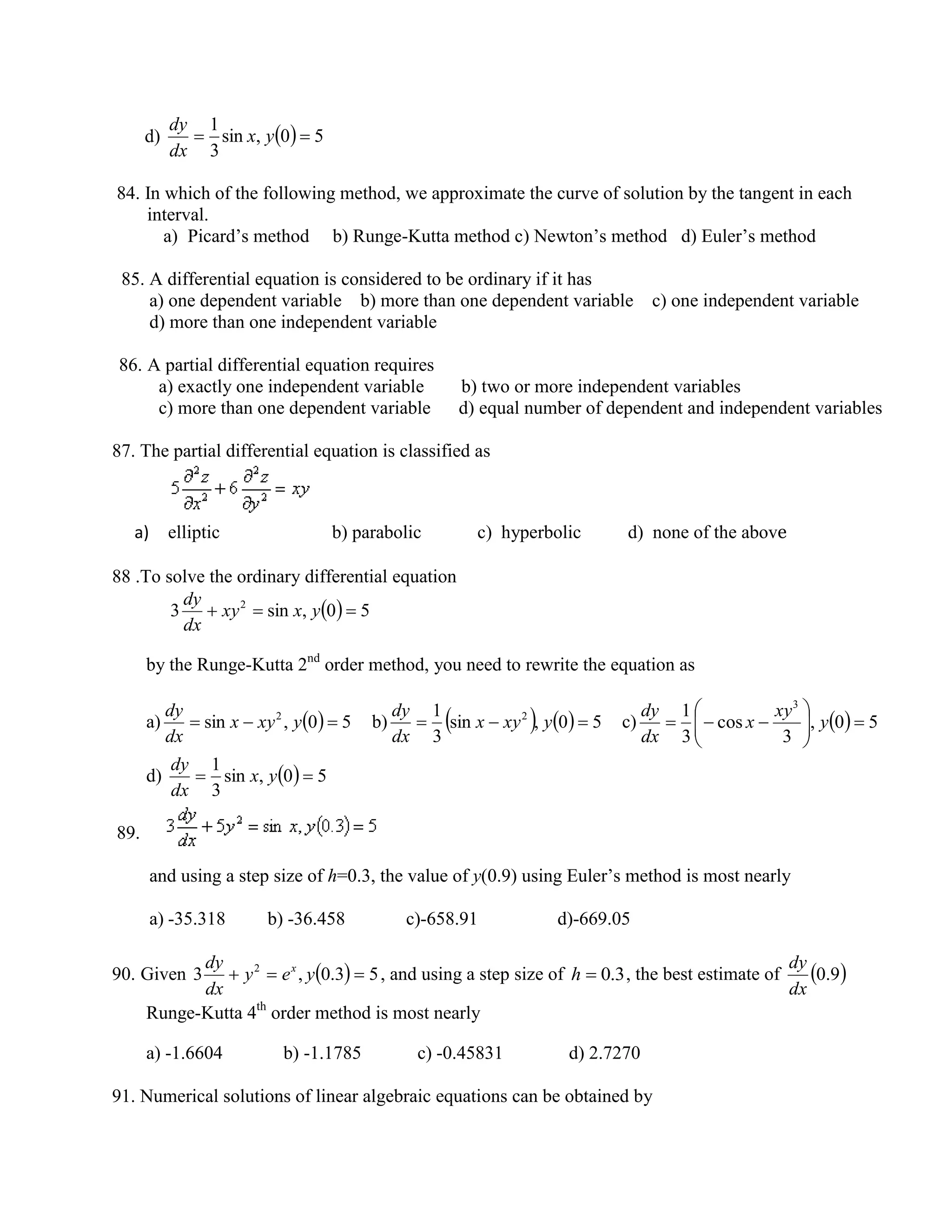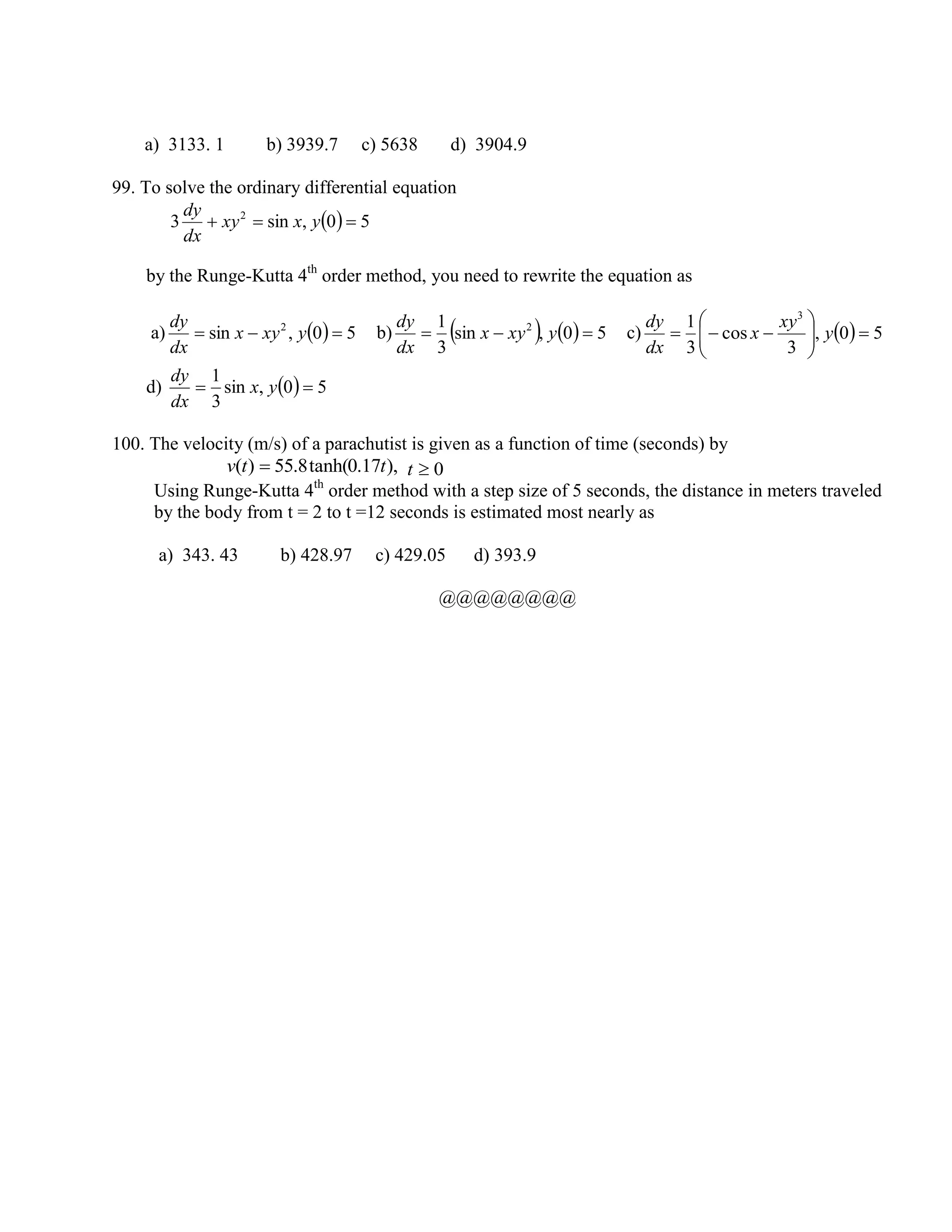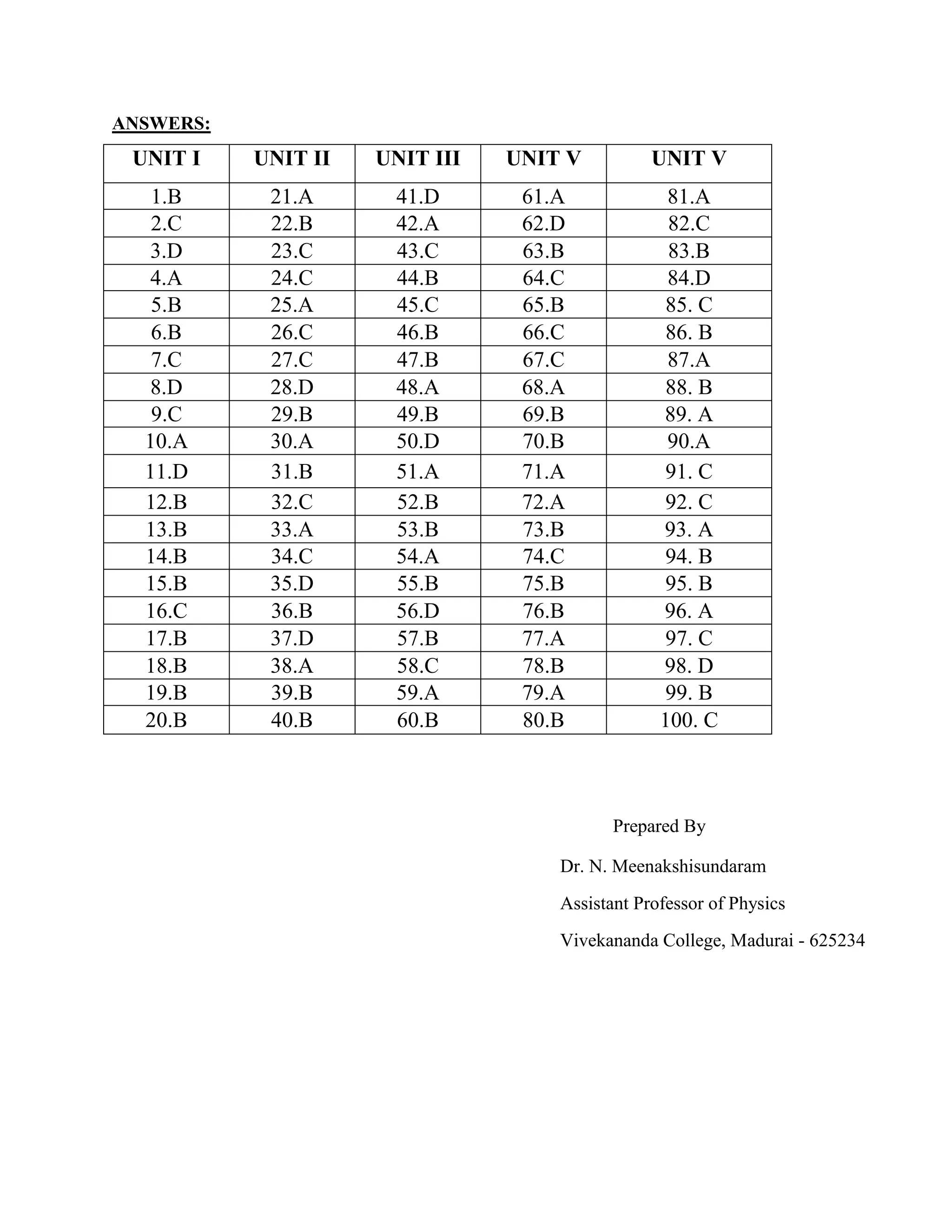This document contains a multiple choice question (MCQ) bank for the subject Numerical Methods. It is divided into three units:
1) Solutions of Numerical Algebraic and Transcendental Equations, which contains questions about root finding methods like bisection, Newton-Raphson, and Regula Falsi.
2) Solutions of Simultaneous Linear Algebraic Equations, containing questions about Gaussian elimination and Gauss-Jordan methods.
3) Interpolation, Central Difference Interpolation Formulae, with questions on polynomial interpolation, Gauss forward/backward interpolation, and Newton interpolation formulas.
The MCQ bank was prepared by Dr. N. Meenakhisundaram of the Department
![VIVEKANANDA COLLEGE, TIRUVEDAKAM WEST
DEPARTMENT OF PHYSICS
MCQ Question Bank for
NUMERICAL METHODS – 06CT42 (April 2020)
Prepared by Dr. N.Meenakhisundaram
Unit - I: The Solutions of Numerical Algebraic and Transcendental Equations:
1.f(x) = 2x3
– 9x2
+ 12x + 6 is a polynomial of degree
a) two b) three c) one d) four
2. f(x) = a + bex
+ c sinx + d log x is an example of
a) algebraic equation b) polynomial equation c) transcendental equation d) linear equation
3. Find the odd one out
a) Bisection method b) Bolzano’s method c) Interval halving method d) Regula-Falsi method
4. Newton Raphson method is also called
a) Method of tangents b) Method of Chords c) Bisection method d) All the above
5. Newton’s method uses
a) Euler’s algorithm b) Taylor expansion c) Interpolation formula d) Lagrange algorithm
6. Order of convergence of Newton Raphson method is
a) 1 b) 2 c) 2.5 d) 1.8
7. An iteration method the condition for the convergence of the sequence to the root is
a) x c b) ' 1x c) ' 1x d) ' 1x
8. If )(xf is a real continuous function in ],[ ba , and 0)( bfaf , then for 0xf , there is (are)
_________ in the domain ],[ ba .
a) one root b) an undeterminable number of roots c) no root d) at least one root
9. For an equation like 02
x , a root exists at 0x . The bisection method cannot be adopted to solve
this equation in spite of the root existing at 0x because the function 2
xxf
a) is a polynomial b) has repeated roots at 0x c) is always non-negative d) has a slope equal to
zero at 0x
10. Choose the algebraic equation from the following _____________________.
a) 2
1 0x x b) 3 sin 2 0x x c) log sin 2 0x x d) 2
2 sin 0x
e x x
11. Choose the transcendental equation from the following _________________.
a) 3
1 0x b) 2
1 0x x c) 1x d) 1 0x
e ](https://image.slidesharecdn.com/mcq-nm-06ct42-2020-200505023725/75/Multiple-Choice-Questions-Numerical-Methods-1-2048.jpg)

![25. Gauss Jordan method is __________________ method.
a) direct b) indirect c) interactive d) iterative
26. The modification of Gauss elimination method is Gauss ______ method.
a) Elimination b) Jacobi c) Jordan d) Seidal
27. Gauss elimination and Gauss Jordan methods are _______.
a) iterative b) interpolation c) direct d) indirect
28. In the Gauss elimination method for solving a system of linear algebraic equations,
triangularization leads to
a) diagonal matrix b) lower triangular matrix c) singular matrix d) upper triangular matrix
29.Given [A] = then [A] is a ______________ matrix.
a) diagonal matrix b) upper triangular matrix c) singular matrix d) lower triangular matrix
30. A square matrix [A] is lower triangular if
a) ijaij ,0 b) jiaij ,0 c) jiaij ,0 d) ijaij ,0
31. The following system of equations has ____________ solution(s).
x + y = 2; 6x+6y =12
a) no b) infinite c) two d) unique
32. Division by zero during forward elimination steps in Naïve Gaussian elimination of the set of
equations [A][X]=[C] implies the coefficient matrix [A] is
a) invertible b) nonsingular c) not determinable to be singular or nonsingular d) singular
33. Consider the following system of linear equation
3x + y – z = 10, x + 5y + 2z = 18, x + 4 y + 9z = 16
If current approximation is x = 3.33, y = 2.93, z= 0.1, then the Gauss-Seidal method will give
next approximation as x = 2.39, y = 3.08 and z =
a) 1.2 b) 0.21 c) 0.14 d) 0.19
34. Consider the following system of linear equation
3x + y + z = 0, x + 4y – z = 1, 2x – y + 5z = 2
If current approximation is x = 0, y = 0.25, z= 0.45, then the Gauss-Seidal method will give next
approximation as x = – 0.23, y = 0.42 and z =
a) 0.58 b) 0.48 c) 0.7 d) 0.24
35. The goal of forward elimination steps in Naive Gauss elimination method is to reduce the coefficient
matrix to a (an) _____________ matrix.
6 2 3 9
0 1 2 3
0 0 4 5
0 0 0 6
](https://image.slidesharecdn.com/mcq-nm-06ct42-2020-200505023725/75/Multiple-Choice-Questions-Numerical-Methods-3-2048.jpg)
![a) diagonal b) identity c) lower triangular d) upper triangular
36. A square matrix [A]nxn is diagonally dominant if
a) ,
1
n
ji
j
ijii aa i = 1, 2, …, b) ,
1
n
ji
j
ijii aa i = 1, 2, …, n and ,
1
n
ji
j
ijii aa for any i = 1, 2, …, n
c) ,
1
n
j
ijii aa i = 1, 2, …, n and ,
1
n
j
ijii aa for any i = 1, 2, …, n d) ,
1
n
j
ijii aa i = 1, 2, …, n
37. Which of the following statement is wrong?
a) If two linear systems have the same solution set, then they are equivalent.
b) The augmented matrix and the coefficient matrix of a linear system have the same number of rows
c) For a linear system, the number of columns of augmented matrix is larger than the number of
columns of coefficient matrix by 1
d) The augmented matrix and coefficient matrix have the same number of columns
38. Which of the following statement is true?
a) Each elementary row operation on an augmented matrix never change the solution set of the
associated linear system b) Two matrices are equivalent if they have the same number of rows
c) If two linear systems have the same solution set, then they have the same augmented matrix
d) It two linear systems have the same coefficient matrix, then they have the same solution set
39. Which of the following row operations on a matrix may not be an elementary operation?
a) replace one row by the sum of itself and other two rows b) multiply all entries of a row by a
number c) interchange the first row and the last row d) replace one row by the difference of itself
and another row
40. To ensure that the following system of equations,
17257
52
61172
321
321
321
xxx
xxx
xxx
converges using Gauss-Seidel Method, one can rewrite the above equations as follows:
a)
17
5
6
257
121
1172
3
2
1
x
x
x
b)
6
5
17
1172
121
257
3
2
1
x
x
x
c)
17
5
6
1172
121
257
3
2
1
x
x
x
d) The equations cannot be rewritten in a form to ensure convergence
Unit - III: Interpolation, Central Difference Interpolation Formulae
41. Polynomial Interpolation is used to compute
a) values of argument b) integration c) differentiation d) all the above
42. Which among the following is correct?
a) E = 1 + b) E = 1 - c) E = d) E = - 1](https://image.slidesharecdn.com/mcq-nm-06ct42-2020-200505023725/75/Multiple-Choice-Questions-Numerical-Methods-4-2048.jpg)
